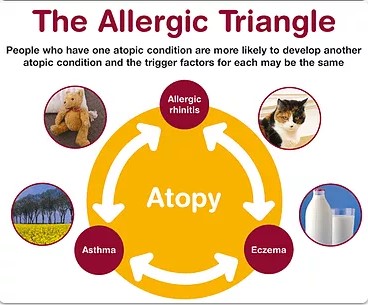What is the Atopy?
Atopy is the genetic tendency to develop the classic allergic diseases — atopic dermatitis, allergic rhinitis (hay fever), and asthma. Atopy involves the capacity to produce IgE Antibodies in response to common environmental proteins such as house dust mite, grass pollen, and food allergens.*
What are the causes of Atopy?
Atopy appears to show a strong hereditary component. Some studies also suggest that the maternal diet during pregnancy may be a causal factor in atopic diseases (including asthma) in offspring, suggesting that consumption of antioxidants, certain lipids, and/or a Mediterranean diet may help to prevent atopic diseases.
What are the treatments?
Avoiding allergens and irritants: See eczema for information.
Avoiding dry skin: Dry skin is a common feature of patients with atopic eczema (see also eczema for information), and can exacerbate atopic eczema.
Corticosteroids: For years, there was no treatment for atopic eczema. Oral Cortisone was sometimes prescribed for severe cases. Wet wraps (covering the patients with gauze) were sometimes used in hospitals to control itching. However, the topical creams and ointments, provided a significant advancement in the treatment of atopic eczema and other conditions. Thus, the use of topical steroids avoided many of the undesirable side effects of systemic administration of corticosteroids.
Immune modulators: Pimecrolimus and tacrolimus (Elidel cream and Protopic oint) creams and ointments became available in the 1980s, and are sometimes prescribed for atopic eczema.

